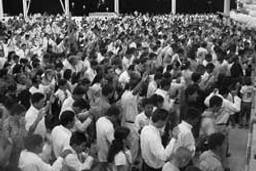In March 1989, University of Texas at Austin premed student Mark Kilroy disappeared during a drunken spree that led him and hundreds of spring-breakers from South Padre Island across the Texas border into Matamoros, Mexico. What promised to be a carefree week of surf, sun and cheap Mexican liquor became grisly grist for tabloids, as an international manhunt eventually discovered Kilroy’s body and the mutilated remains of at least a dozen others in a mass grave, located at what came to be known as Hell Ranch.
The gruesome slaughter of mostly poor Mexicans might have been buried forever had it not been for Kilroy, a clean-cut American with family connections to U.S. Customs authorities. It turned out that a drug-running cult had ritually sacrificed these victims to dark forces in order to secure supernatural protection against the police. Inspired by a mix of Caribbean religions and voodoo-themed movies such as The Believers, the cult’s charismatic leader subsequently expired in a bloody shootout with Mexico City federales.
Likewise inspired, the hardcore narco-Satánico death metal group Brujería seized on the Hell Ranch butchery as a symbol of cultural resistance to Anglo incursion, tapping into the nexus of history and hysteria surrounding the status of Mexicans in the United States. But far from an earnest commitment to the prince of darkness, their embrace of horrific, diabolical imagery consists more of that American rock pose—scaring the hell out of mom and dad, whether through pelvis-shaking rhythms or parental advisory warnings. Scholar José Limón described this balance of Latino cultural accommodation—specifically through the mix of music and communal standards—as a sort of boogie-woogie with Beelzebub, in 1994’s Dancing With the Devil: Society and Cultural Poetics in Mexican-American South Texas.
On October 2, 2003, a rock show at Chicago’s Aragon Ballroom commemorated the 35th anniversary of another such massacre, of student protestors at Tlatelolco, Mexico City. But 18-year-old Mex-American rockero Erik Duarte hadn’t heard about lurid 1989 machete murders in Matamoros or about recently declassified documents showing that government snipers opened fire on the students in 1968. His teenage band Kardoid opened for Brujería, launching into the chorus of their song “Amén”: “¡Soy Satánico!” (I am Satanic!). The audience of largely Mex-descent teens and twentysomethings, clad in camouflage and Guevara chic, responded raucously with the rock cliché devil sign, holding up the index and pinky fingers to mime Satan’s horns. “‘Soy Satánico’ means I’m tired of being judged as a freak for how I dress and the music I listen to,” Duarte emotes over the feedback. “It’s like saying I’m your worst nightmare, I’m the devil, whatever you’re afraid of.”
Typically, in much Latin hard rock, crunching power chords conflate politics and pop culture, and the Mexican grito—a commonplace vocalization of sorrow and celebration—serves as the rockero gloss on everything from European conquest to immigrant reconquista of the Americas.
Recasting Norteño accordion music, Brujería metallizes the narco-corrido, an updated troubadour tradition that lionizes smugglers and border-hoppers to the status of national heroes. And honoring Subcomandante Marcos, band members cloak their faces in macho outlaw pose, adopting such nom de guerre monikers as Juan Brujo (Juan Witch), Asesino (Assassin), and Fantasma (Phantasm). They claim consort with Satan, sing the praises of the mom-and-pop-killing Menendez Brothers and Colombian drug lord Pablo Escobar and exhort every pot-smoking greñudo (longhair) to spill whitey’s blood on turf stolen from Mexico (e.g. the album Matando Güeros, “Killing Honkies”). Chronicling current events much like corrido singers, Brujería speaks to such travails as Proposition 187 (on the song “Pito Wilson”), border-crossing casualties (“La Migra”), and the Zapatista uprising (“Revolución”). On the track “Consejos Narcos” (“Advice for Narcos”), Juan Brujo articulates the basic truths of drug running for Satanists. In a humorously bizarre equation, he also reduces nightmarish fantasies of Satanism and Communism to the reality of the Mexican P.R.I. : “Comunismo, Satanismo, P.R.I.—es lo mismo (“Revolución”).
The recent Best of Brujería release charts the band’s rise as a pioneering Spanish-language metal band formed from Mexican rockers and American collaborators. With liner notes by Hank Williams III, the disc gives a sense of their aggressive pose effected by an aural barrage of growling, slashing barbarity that sounds anything but typically “Mexican.” But as their recent show at the Aragon demonstrates, Brujería is proof of rock ’n’ roll’s absorption into the immigrant soul—as a space of simultaneous resistance and capitulation to bedeviling American culture.
The gruesome slaughter of mostly poor Mexicans might have been buried forever had it not been for Kilroy, a clean-cut American with family connections to U.S. Customs authorities. It turned out that a drug-running cult had ritually sacrificed these victims to dark forces in order to secure supernatural protection against the police. Inspired by a mix of Caribbean religions and voodoo-themed movies such as The Believers, the cult’s charismatic leader subsequently expired in a bloody shootout with Mexico City federales.
Likewise inspired, the hardcore narco-Satánico death metal group Brujería seized on the Hell Ranch butchery as a symbol of cultural resistance to Anglo incursion, tapping into the nexus of history and hysteria surrounding the status of Mexicans in the United States. But far from an earnest commitment to the prince of darkness, their embrace of horrific, diabolical imagery consists more of that American rock pose—scaring the hell out of mom and dad, whether through pelvis-shaking rhythms or parental advisory warnings. Scholar José Limón described this balance of Latino cultural accommodation—specifically through the mix of music and communal standards—as a sort of boogie-woogie with Beelzebub, in 1994’s Dancing With the Devil: Society and Cultural Poetics in Mexican-American South Texas.
On October 2, 2003, a rock show at Chicago’s Aragon Ballroom commemorated the 35th anniversary of another such massacre, of student protestors at Tlatelolco, Mexico City. But 18-year-old Mex-American rockero Erik Duarte hadn’t heard about lurid 1989 machete murders in Matamoros or about recently declassified documents showing that government snipers opened fire on the students in 1968. His teenage band Kardoid opened for Brujería, launching into the chorus of their song “Amén”: “¡Soy Satánico!” (I am Satanic!). The audience of largely Mex-descent teens and twentysomethings, clad in camouflage and Guevara chic, responded raucously with the rock cliché devil sign, holding up the index and pinky fingers to mime Satan’s horns. “‘Soy Satánico’ means I’m tired of being judged as a freak for how I dress and the music I listen to,” Duarte emotes over the feedback. “It’s like saying I’m your worst nightmare, I’m the devil, whatever you’re afraid of.”
Typically, in much Latin hard rock, crunching power chords conflate politics and pop culture, and the Mexican grito—a commonplace vocalization of sorrow and celebration—serves as the rockero gloss on everything from European conquest to immigrant reconquista of the Americas.
Recasting Norteño accordion music, Brujería metallizes the narco-corrido, an updated troubadour tradition that lionizes smugglers and border-hoppers to the status of national heroes. And honoring Subcomandante Marcos, band members cloak their faces in macho outlaw pose, adopting such nom de guerre monikers as Juan Brujo (Juan Witch), Asesino (Assassin), and Fantasma (Phantasm). They claim consort with Satan, sing the praises of the mom-and-pop-killing Menendez Brothers and Colombian drug lord Pablo Escobar and exhort every pot-smoking greñudo (longhair) to spill whitey’s blood on turf stolen from Mexico (e.g. the album Matando Güeros, “Killing Honkies”). Chronicling current events much like corrido singers, Brujería speaks to such travails as Proposition 187 (on the song “Pito Wilson”), border-crossing casualties (“La Migra”), and the Zapatista uprising (“Revolución”). On the track “Consejos Narcos” (“Advice for Narcos”), Juan Brujo articulates the basic truths of drug running for Satanists. In a humorously bizarre equation, he also reduces nightmarish fantasies of Satanism and Communism to the reality of the Mexican P.R.I. : “Comunismo, Satanismo, P.R.I.—es lo mismo (“Revolución”).
The recent Best of Brujería release charts the band’s rise as a pioneering Spanish-language metal band formed from Mexican rockers and American collaborators. With liner notes by Hank Williams III, the disc gives a sense of their aggressive pose effected by an aural barrage of growling, slashing barbarity that sounds anything but typically “Mexican.” But as their recent show at the Aragon demonstrates, Brujería is proof of rock ’n’ roll’s absorption into the immigrant soul—as a space of simultaneous resistance and capitulation to bedeviling American culture.
Benjamin Ortiz is a writer based in Chicago.






